It’s just before 8:45 p.m. on April 20, 2020, about a month into the COVID-19 pandemic lockdown in the Los Angeles suburb of Westlake Village, and I’m waiting for our family’s harasser to show up.
Specifically, I’m hiding in the back of my mom’s SUV, wearing a black hoodie and holding a walkie-talkie in one hand and a can of pepper spray in the other. The car is in its usual spot in the driveway of our two-story home, the second-to-last house at the top of a steep hill, just before a cul-de-sac. It’s especially quiet up here tonight. No traffic. No pedestrians. Just the star-speckled sky and the silhouettes of the Santa Monica Mountains.
My pulse thumps loudly, and my body is tense with a fear I’ve never felt before. Even though the car is locked, and even though my parents are inside watching me on the security cameras, I can’t help but wonder what could happen if I cough or sneeze or, more realistically, start shaking so uncontrollably that I make a noise. Will he run? Will he come toward the car and peer through the tinted window? It’s been over an hour and he’s due any time now. I practice taking slow, deep breaths.
Then it happens.
From the corner of my eye, I detect movement among the stillness. A man emerges from the darkness, ascending our steep street. I watch in a state of adrenaline-fueled paralysis as this stranger gets closer. Thanks to a streetlamp, I have a clear view. His eyes scan our home, darting from window to window for any signs of detection. I silently plead with myself to stay calm as he passes within 10 feet of me, his gaze landing on the car’s dark rear window — the only barrier separating us. I hold my breath. A split second passes before he beelines toward our mailbox and opens it.
Slowly, shakily, I raise the walkie-talkie to my lips, quivering in disbelief at what I’m witnessing firsthand after all this time. “Carole Baskin,” I say into the speaker. “I repeat, Carole Baskin is here.”
Carole Baskin, of course, is the infamous feline fanatic featured in Tiger King, the Netflix docuseries that Americans have been devouring during these early days of quarantine. But to my family and me, “Carole Baskin” is the code name for a man who sows fear and inspires a revulsion not unlike what the show’s protagonist, Joe Exotic, feels for his activist archnemesis. No large cats were harmed in the making of this story, but my family and I — particularly my two younger sisters and me — were haunted night after night, constantly looking over our shoulders and often afraid to be at home. I think that gives us the right to add some levity to this dark, surreal episode of our lives.
So tonight, while the rest of the world is wrapping up Zoom yoga classes, trying their carefully washed hands at sourdough starters, or worrying where their next paycheck will come from, my family and I have been focused on something entirely different: catching the man who has been harassing us and ending his perverse reign of terror once and for all.
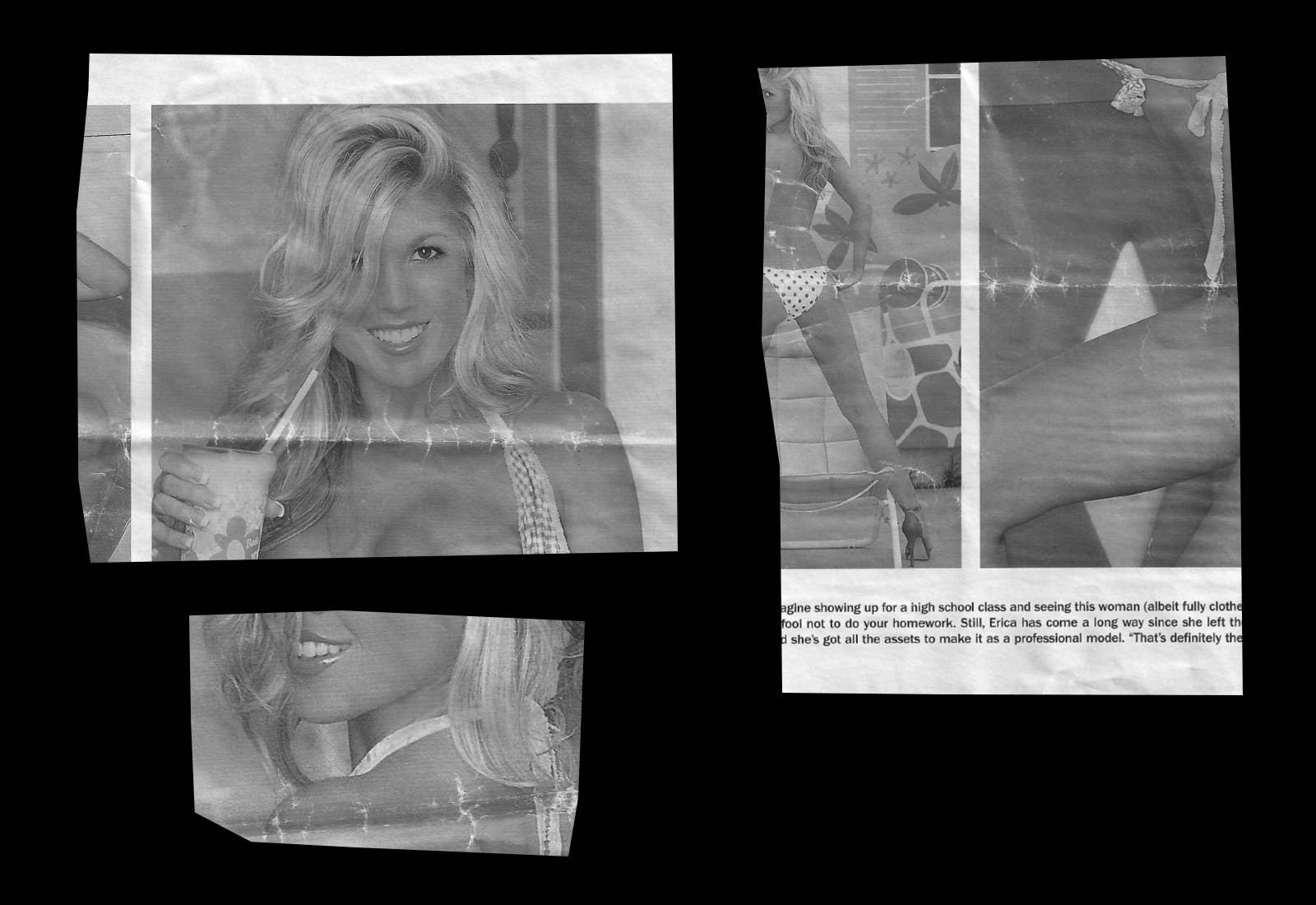
Nonsensical notes and nude pics
To understand how my family and I wound up spending the pandemic surveilling our harasser, you need to rewind half a decade. In early 2015, I was a 19-year-old sophomore at New York University enduring my first polar vortex. Back home, my sister Brooke, 17, was starting her last semester at our local public high school, while my youngest sister, 15-year-old Summer, attended a private school.
That’s when the first note appeared on the windshield of our white Jeep Wrangler, which Brooke had been driving regularly and which was usually parked in our driveway. The note was typed in a small, generic font on regular printer paper and wasn’t addressed to anyone in particular. Although we don’t remember the exact message, it was short, and we distinctly recall the author’s secret-admirer writing style, with its childish tone and poor grammar. The letter was unsigned and unremarkable, either an innocent gesture or a friendly prank, we figured, so we threw it out.
A couple of weeks later, on Feb. 12, a second note appeared under the windshield wipers on the Jeep. Addressed again to no one, it was cryptic. It was also really creepy:
Thanks for returning the picture, you don’t have straight hair anyways---I guess you don’t like red for valentines? Its all for fun and I wonder if anyone has ever made you think what is next-the anticipation is the best part- enjoy the starbucks and if you want, future gifts to enjoy?
Huh? What picture was the sender thanking us for supposedly returning? And what was the gibberish about not liking red for Valentine’s Day or the bit about straight hair? And what Starbucks was one of us meant to “enjoy”? The note was unsettling enough that we hung onto it.
Eight days later, note #3 appeared on the Jeep:
I know you like starbucks. I got you something so you can enjoy your favorite drink or two. Its in the normal hiding spot.
BTW, Happy Valentine’s Day :)
SM
The references still eluded us, as did the whereabouts of the so-called “normal hiding spot,” although my family searched the perimeter of our house thoroughly. But there was a more puzzling question: Who was “SM”? We racked our brains, scoured our school phone directories and Instagram followers for a suspect with those initials, to no avail. Was “SM” just an alias? Regardless, we were now officially spooked. Summer was so petrified she started sleeping with kitchen knives hidden throughout her room.
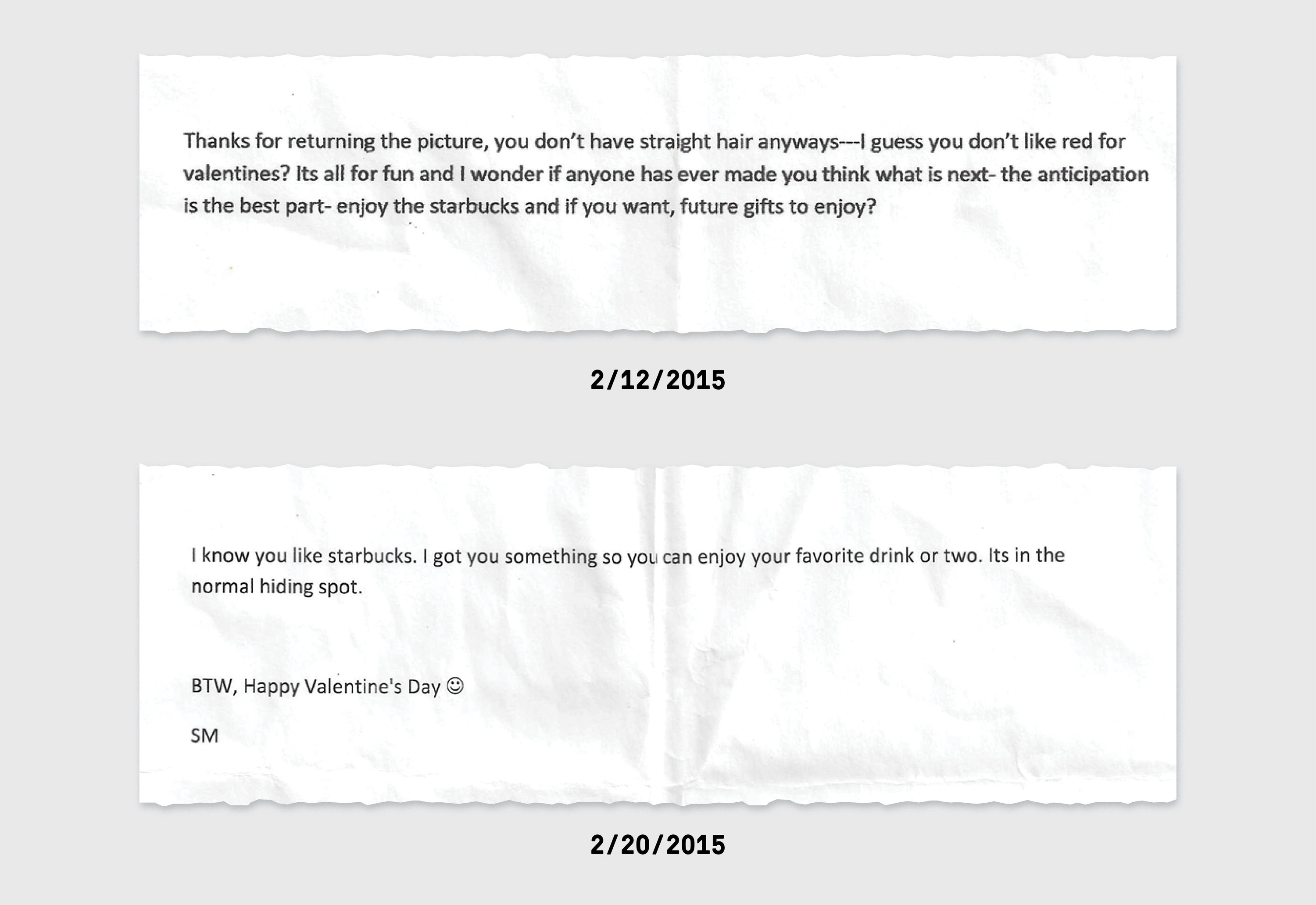
A month later, the stranger took things to the next level with another letter that was accompanied by a torn-out page from a Playboy-type magazine with a picture of a nude dark-haired woman who appeared to be Latina. Not wanting to further distress our youngest sister or our already hyper-paranoid father, Brooke panicked and threw away the note, although she recounted that the message said something about the naked woman being “your twin.” This was especially confusing, considering that Brooke has red hair, Summer has blonde hair, and all three of us are white. Was this person not aware of what we looked like? Or was bewildering us all a part of some twisted game? Either way, we felt that this was no harmless secret admirer but a sexually motivated harasser. Around our house, my family refers to this person by a much more sinister term than “harasser,” but my editor wouldn’t let me use it in this story.
One week later, Brooke found a box of chocolates on the Jeep. Then she found a fifth note. It was addressed to “S,” presumably for Summer.
S
Did you see my last note to you? The box behind the wall has something that reminds me of when we met. Interesting….
SM
What box? What wall? Who is this freak?
Twice that February, we found roses on our property. Sometime around March 25, a neighbor told Summer that she’d left some babysitting money she owed her, along with one of Summer’s sweatshirts, in our mailbox. But when Summer checked, the mailbox was empty. We had our suspicions.
On April 2, they were confirmed. Still curious about the “box behind the wall” and the “normal hiding spot,” my mom ventured over the wall in the cul-de-sac that separates the street from a grassy hiking trailhead, and, sure enough, there it was: a box nestled beneath some branches.
Inside, she found a half-assed shrine composed of stolen belongings and childish gifts: Summer’s missing sweatshirt, the envelope of babysitting money, which had been emptied and ripped in half, a Starbucks gift card, a beaded bracelet, a college postcard addressed to Summer that we had thrown in our trash, and a sticker of Summer’s high school logo. My mom retrieved Summer’s possessions and snapped pictures of the contents but put the box back in its original spot, not wanting this person to think my sister had accepted their offerings.
My parents filed a report with our local cops, the LA County Sheriff’s Department station in Lost Hills, but nothing came of it; we had neither received any explicit threats of violence nor had any leads.
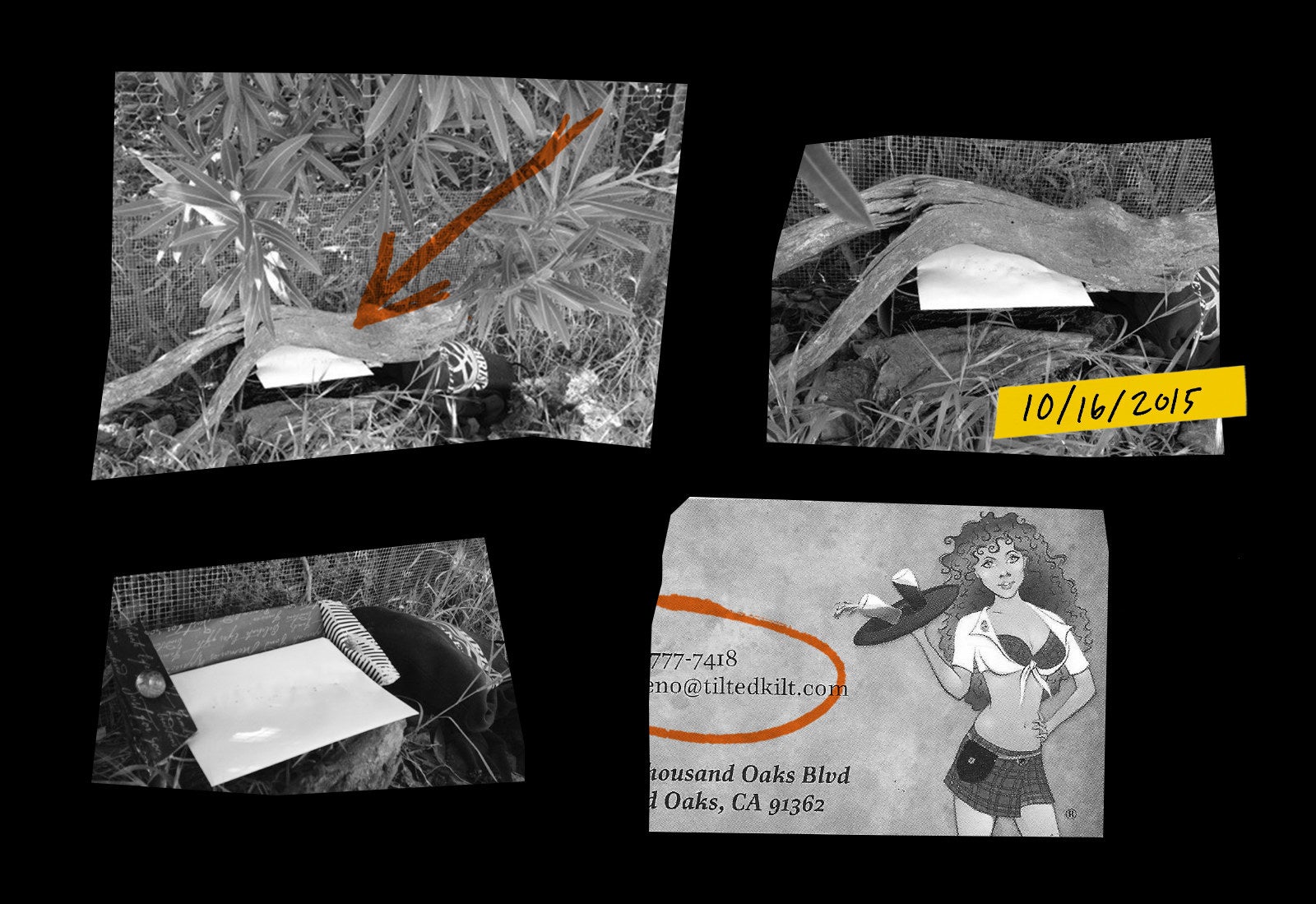
Confrontation by the mailbox
My family stayed on high alert that spring 2015. One evening in late April, my highly protective dad was doing a routine window check when he spotted a man walking a small black-and-white dog. The man opened our mailbox, peered inside with what looked like a laser light, and then closed it.
My dad darted outside to confront the stranger. “Were you just looking in my mailbox?”
The guy said something along the lines of “Uh, no, there was a dog barking.”
My dad challenged him, but the guy walked away. High on adrenaline and unsure what to do, my dad ducked into the house, grabbed his keys, jumped in the car, and drove along next to the guy. He looked to be a white guy in his late 40s, balding, forgettably dressed, neither tall nor short. He kept his eyes locked forward and continued briskly down the street while my dad followed him in hopes of seeing where he lived and taking his picture. But when my dad realized he’d forgotten his cellphone, he impulsively made a U-turn and sped back home. When he returned moments later, the man was nowhere in sight.
Up to that point, we’d been convinced the culprit was an awkward teenager — some lonely perverted incel. We even had a kid who lived close by in mind. But this guy at our mailbox forced us to rethink our suspicions. Could this grown man truly be the creep behind all the disturbing notes and stolen items? Was the pathetic writing style all a ploy to sound more adolescent? Yet at the same time, we had nothing else to connect this guy to the shrine box or the notes; we had to consider that this was all a strange, timely coincidence. The neighbor-kid theory was easier to believe.
But as much as we had hoped the mailbox incident was unrelated, it became harder to discount. A few days later, when my parents went back over the cul-de-sac wall to check on the box, it was gone. We had installed security cameras on our house, but all the notes and gifts ceased.
For about five months.
In October 2015, we found note #6. It read, in part: “Hi summer, You should work at the TK,” a reference to the Tilted Kilt, a local Hooters-inspired Scottish tavern where the women servers are scantily clad in mini kilts. Attached to the note was the restaurant's business card. To our dismay, our new motion-activated security cameras didn’t capture anything, so my parents drove to the Tilted Kilt, but that was a dead end.
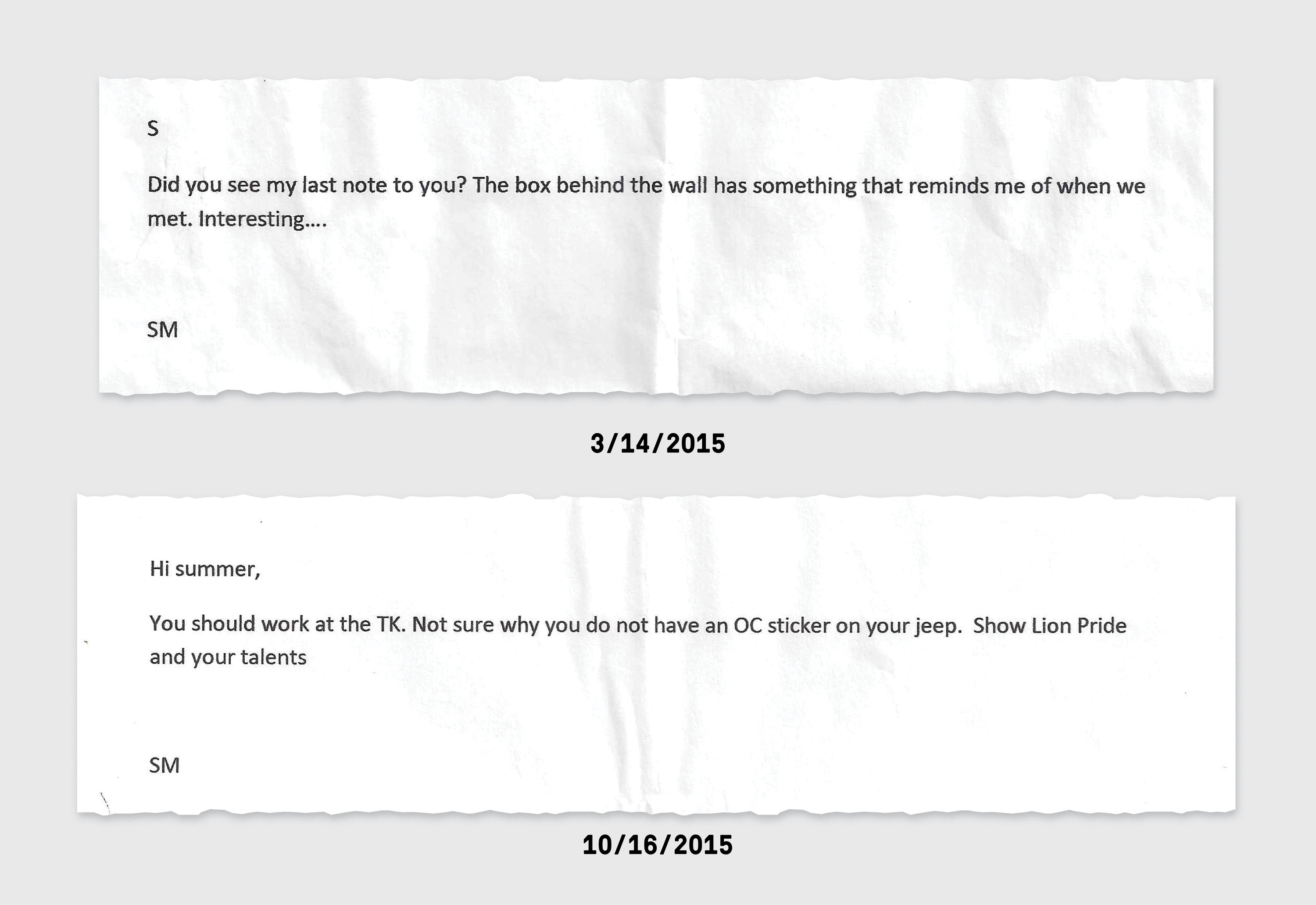
A few weeks later, though, we had a stroke of luck. My parents were driving home one evening when my dad recognized the man from the mailbox walking the same small dog in our neighborhood. Once they’d passed him, they drove out of sight, then my dad got out of the car and inconspicuously followed him on foot. The man went inside a house less than a mile from ours.
Just a guy trying to empower women
In order to mitigate the risk of retaliation against my family, I’ll call the man “the neighbor” or “our harasser” instead of using his real name. My editor at BuzzFeed News tried to contact him to give him a chance to respond to the information in this story, including sending a letter through a lawyer who represented him, but he didn’t reply to the messages and none of the phone numbers listed under his name led to him, either.
During fall 2015, the neighbor was a middle-aged husband and father living in our town of Westlake Village in Los Angeles County. He studied at a state university and found success as a wealth management adviser to affluent families in the region. He worked at a major national bank — the one we banked at, in fact — and was recognized as an industry leader by trade publications. He was involved in a variety of local charity and youth organizations. In other words, he was a prominent figure in the community.
But there was one portion of his résumé that jumped out at us. The neighbor, of all people, was affiliated with an organization dedicated to providing career and education opportunities for women and girls. The local wealth management firm he had cofounded even hosted an annual event aimed at supporting women in the community.
How? By preying on them before they’re old enough to drive? By terrifying them with ominous notes and gifts? By taking their babysitting money? By lurking in their neighborhoods and leaving cutouts from porn magazines on their windshields?
When my parents shared their findings with Summer, she didn’t recognize the neighbor’s name or picture. However, we quickly figured out that he had a child who attended her high school, though this classmate and my sister had never spoken. In other words, our harasser was...a local school dad.
Even more alarming, Summer was fairly confident that she’d seen this kid when we’d been on vacation in Hawaii — not long after the mailbox confrontation but before we’d figured out his identity. We were waiting for an elevator at a hotel when the doors opened and Summer recognized the kid who got off. She didn’t take much notice of the man with the kid but assumed he was the father.
That sighting, if Summer’s memory was correct, raised an eerie question: If this man really was our harasser, did he actually follow us halfway across the Pacific? Could he have pried into our bank accounts and seen that we had purchased plane tickets? Or was that paranoia speaking? Were we being completely irrational by even considering the possibility?
We might never know for sure if the neighbor and his kid were vacationing in the same place as us — and, if it was them, whether it was a coincidence or his most calculated move yet. But the latter seemed too far-fetched, too next-level scary to believe, and in hindsight I think our doubts about that theory colored what we had let ourselves believe about the neighbor. Just as we couldn’t prove that he’d followed us to Hawaii, we didn’t have any solid evidence that he’d done anything more than peer into our mailbox that one time. We tried to employ reason over speculation. Maybe Summer didn’t see his kid on vacation. Maybe the neighbor really was looking for a barking dog rather than snooping in our mailbox.
I know this all might sound naive, but at the time it made sense because, once again, everything stopped. After note #6 in October 2015, there were no more letters, no more gifts behind the wall...for four years. Maybe, we thought, it really was that teenager from our neighborhood and that he’d finally outgrown his weird obsession or went away to college. We didn’t have the answers we’d hoped for, but we found consolation in knowing that our family’s harasser had retired.
Except he hadn’t.
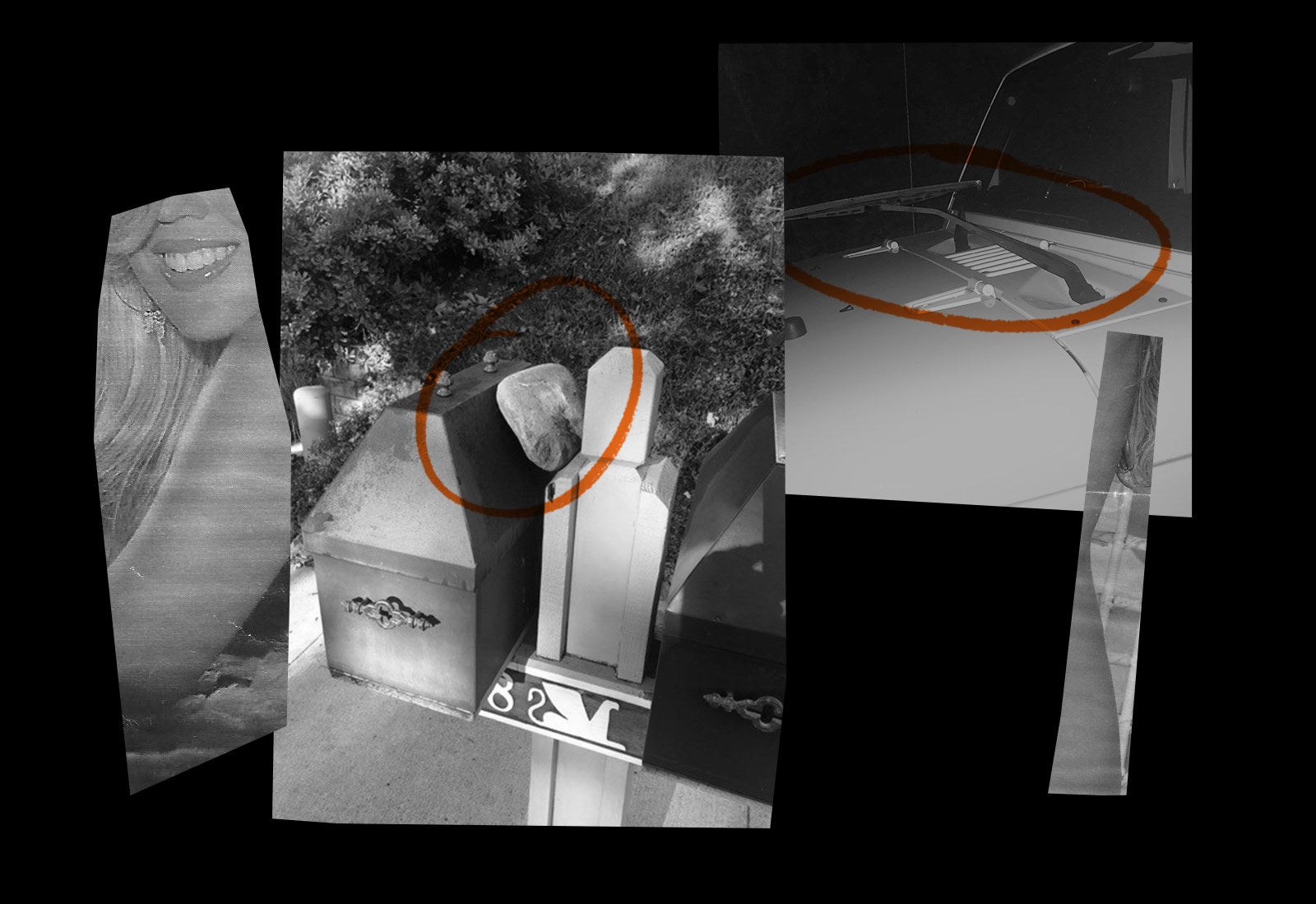
A new target: me
In fall 2019, Brooke was living in Spain. Summer was enrolled at the University of Colorado Boulder for a couple years, but had just returned to California with hopes of transferring to a local school and was living in the San Fernando Valley. I’d just landed a job in West Hollywood and was commuting from my parents’ house while looking for an apartment in the city.
One night while my parents were out of town, I pulled into the driveway in the Jeep — the same one my sisters and I had been sharing for years. Our other shared car, an old Acura, was parked on the street. I noticed that one of the windshield wipers was sticking straight up. It seemed odd, but I didn’t think much of it and put the wiper down.
But over the next few weeks, it happened again. And again. And again. We checked the surveillance footage, but the cameras hadn’t been activated by the perpetrator’s motion. I tried not to dwell on it, but a question burned in the back of my brain: After four years, was our harasser back? I got my answer when we found note #7 on the Acura’s windshield. It included another cutout from a porn mag, only this time the note was addressed to me. It read, in part:
Tess- you are so darn cute and love watching you drive that jeep. … You are so hot. … See what you look like to me.
The incident was a one-off, probably because I moved to an apartment in LA not long after. But how did this guy know I was the only sister home? It had to be the kid who lived near us, as opposed to the neighbor, who was about a mile away and out of sight.
Whoever it was, we knew we needed real evidence to go back to the police. In 2020, it turned out we’d get plenty.
When the pandemic hit in early March, I found myself temporarily out of a job and back in the suburbs, hunkering down with my parents for what we had all assumed would be a few dull weeks of time off. It was only a matter of days before the windshield wiper shenanigans recommenced. But neither the three motion detection cameras nor the camouflage surveillance camera we’d hidden in our front yard had captured anyone in the act.
Next came note #8, this time addressed to Summer, who was still living elsewhere. It came with more porn cutouts and read:
Nice to see you back from CU. I am back from BU. You still look like you did at [high school] but I know you look like this girl behind those clothes. Miss seeing you and having you near me
SM
A few weeks later, I was looking out a street-facing window for the nth time that night when I jumped. There he was, a man by the mailbox. Middle-aged. Balding. Walking a small black-and-white dog, along with another very large black-and-white dog. I ducked until he was out of sight, then sprinted outside. There, wedged against the top of our mailbox and directly above where the last note had been, was a guinea pig–sized rock that in no way could have materialized there naturally.
It was the neighbor. And this time, the security cameras caught him. The gravity of the situation had finally sunk in. It was really him all along.
Now, we just needed evidence that linked him to the notes and gifts. Armed with our first substantial lead in years and the long days of quarantine, we escalated our efforts into a full-scale covert operation.

Let me remind you here that my parents had already gone to the local sheriff’s station in 2015, and nothing had happened. The neighbor wasn’t yet on our radar, and the cops weren’t about to stake out our house because of a handful of gross notes and trinkets. Sure, we could’ve just gone and knocked on his door, but my dad had already confronted him once. We still couldn’t prove that he had been behind the notes. We knew we needed to give the cops an open-and-shut case.
Which brings me back to the backseat of my mom’s SUV, walkie-talkie to my mouth, confirming to my parents that I’d gotten a positive ID on the neighbor, known to my family as Carole Baskin.
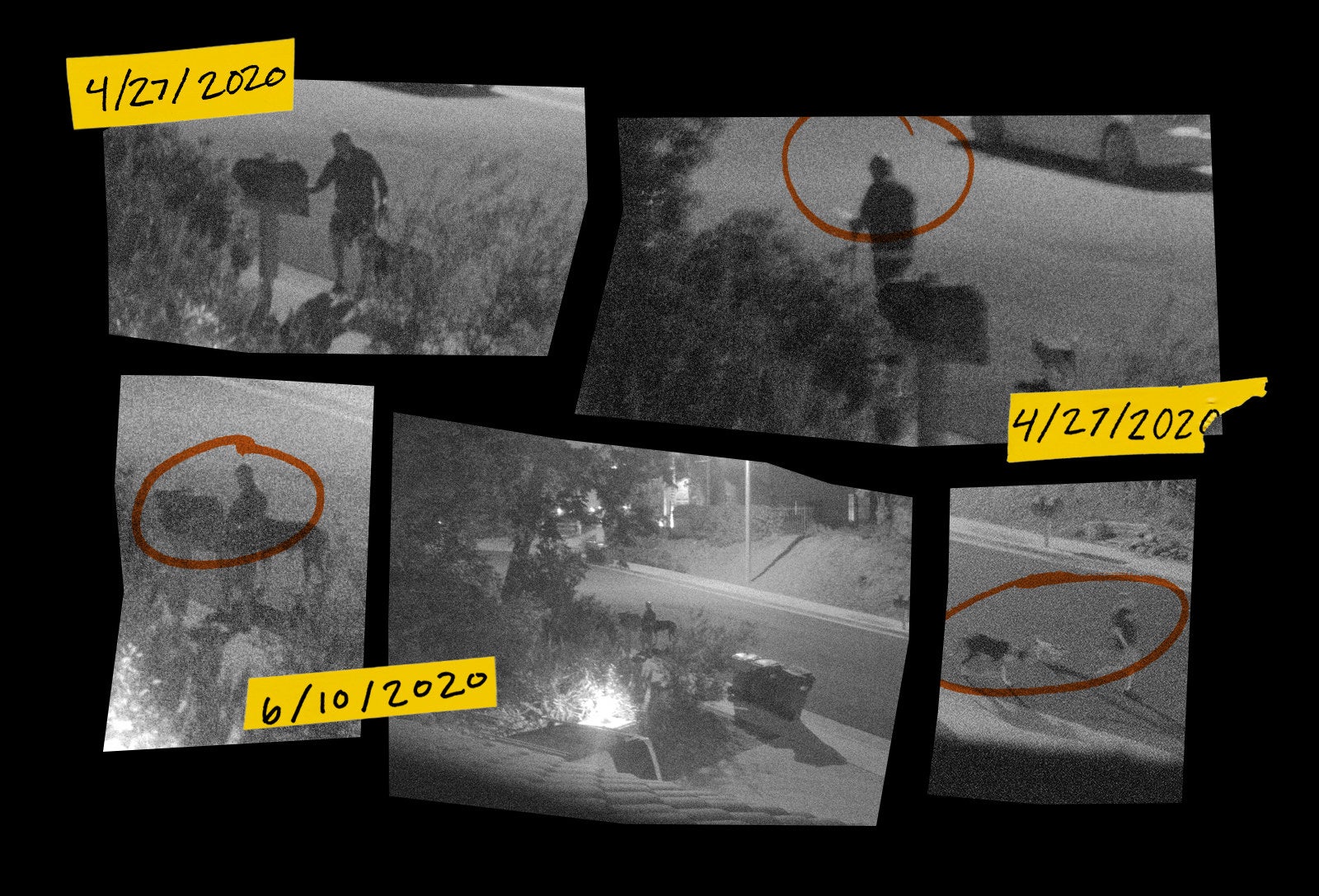
Pushing his limits
Spring 2020 already feels like forever ago. Hospitals were overflowing with the first surge of COVID-19 patients. Panicked shoppers were emptying grocery store shelves and scrambling for toilet paper. Donald Trump was suggesting we kill the virus by injecting ourselves with bleach.
Through it all, my parents and I optimized our operation. Every night at sundown, my mom or I would drive to a side street about halfway between the neighbor’s house and ours, park out of sight, and wait for him to walk by with his dogs. We’d disguised ourselves with hats and sunglasses, and we even borrowed my grandparents’ cars so the neighbor wouldn’t recognize ours. If we saw him en route, we’d radio up to the house, giving my dad about 10 minutes to ensure the surveillance cameras were rolling. The other person stationed at home would then run upstairs to one of the street-facing bedrooms to take still photos with a zoom lens as the neighbor opened our mailbox, messed with the windshield wipers, or rummaged around in our plants. After he left, my dad would radio whoever was on lookout in the car that he was on the way back, and my mom or I would confirm what time the neighbor returned home.
On one occasion, we sent Summer a letter in the mail, figuring that the neighbor was probably aching to find something related to her. As anticipated, he opened our mailbox a day or two later, sorted through our mail, and snatched up the envelope addressed to her — our first recorded encounter linking him directly to Summer, specifically, and maybe even to mail theft.
On June 10, as protests over the police killing of George Floyd coursed through the country, the neighbor took a letter for Summer out of our mailbox and placed it on the Jeep. He started bringing a flashlight and would spend several moments peering into the car, presumably drinking in whatever personal belongings he could make out through the windows.
Some nights, he appeared to play it cool, walking by our house without so much as looking at it. Other nights, a neighbor would drive up just as he was approaching, and on those occasions it looked as if he’d abandoned his mission, just a regular guy out walking his dogs. A few times, he took longer breaks, maybe 10 days off, and we’d worry that he knew we were onto him or that he’d quit without leaving a note. And catching him leaving a note would be vital. It was the last piece of evidence we needed on camera to prove that he wasn’t just some creep who messed with our property but the same person who had been harassing us since 2015. I imagine the withdrawals must be unbearable, though, and the neighbor would inevitably resurface to get his fix.
Around this time, I started doing some research. I wanted to get a glimpse into how dangerous our situation might be. What I found was nightmare-inducing. I’ll spare you the academic explanation, as I’m no psychologist and I know very little about this man other than what I’ve observed. But, according to what I’d read, experts agree there are five types of stalkers, all of which have the potential to harm their victims, although few actually do. But the fifth and one of the rarest types, the “predatory” stalker, is the most terrifying. For predatory stalkers, “Stalking is foreplay; the real goal is sexual assault,” according to Psychology Today, and these people are the most likely to lead “double lives.” One study from the American Journal of Psychiatry states, “There is a troubling lack of warning of danger because they are the least intrusive stalkers, often only glimpsed by their victims.” I can't say what was in the neighbor’s head, but the possibilities running through my mind were bone-chilling.
Given our mounting evidence and everything I’d read, we decided to talk with a friend of a friend, a retired law enforcement officer who lived nearby.
This friend came over one afternoon. My parents began telling our story without naming names. Halfway through, she cut them off. “I know who this is,” she blurted out, and then said the neighbor’s name. My parents were stunned.
A couple in our neighborhood had told her that their niece had had an off-putting experience with him a few years back, she explained. I reached out to the couple to learn the details. The husband told me they’d rarely interacted with the neighbor — they once invited him over for a party — so it was odd when they learned that he had contacted their niece, a college student, and messaged her online. The neighbor told the young woman that he was good friends with her aunt, and that he wanted to get together to discuss investments. This struck everyone as inappropriate and strange, considering that the neighbor had never met the niece, and he wasn’t close with the couple.
The law enforcement friend promised to connect us with a detective when we were ready and encouraged us to keep collecting evidence in the meantime. Best-case scenario, she agreed, was that we actually get him on camera leaving one of his notes.
Two weeks and several stakeouts later, we did. The ninth note was addressed to Summer, who by that point had moved back in with our parents.
S-
OMG. I THOUGHT YOU ARE A CLASSY GIRL LIKING V.S.: YOU LEFT A THONG ON YOUR FRONT SEAT. YOUR NOT THAT GIRL FROM THE [initials of high school] ARE YOU?
I HAVE A “SUMMER” DEAL FOR YOU: LEAVE YOUR PANTIES OUT AND I’LL GET YOU A VS GIFT CARD SO YOU CAN TAKE MORE BACK TO BOULDER?
IF YOU WANT A SUMMER FLING THEN ITS NOW IN YOUR SWIMMING POOL! LEAVE THIS LETTER AND PANTIES BEHIND THE WALL ON TOP OF STREET IN AN ENVELOPE WITH “ralphie” aka SM AND I WILL GET YOU V.S. GIFT CARDS PROMISE!
HAVE A GOOD “SUMMER”
LMK
Ralphie aka SM
We figured “Ralphie” was a reference to the University of Colorado Boulder’s mascot, Ralphie the Buffalo. “V.S.” must have meant Victoria’s Secret, the brand of a pair of underwear I’d left in the car, among other items of clothing. We still didn’t know what “SM” stood for. But it didn’t matter. We finally had what we needed: footage of the neighbor himself, leaving a note. I felt a cocktail of heightened emotions, a mix of disgust at this vile creep and glee for having caught him red-handed. Amped up on adrenaline, my dad and I stayed up late that night analyzing every disgusting detail of this new note, rehashing the neighbor’s every move, repeating, “I can’t believe we did it.”
We got to work putting together what would be a 76-page PowerPoint to present to the authorities. In the meantime, we still had to watch out for the neighbor, who came back two days later, scoured the area where he left the note, then disappeared into the cul-de-sac for longer than normal. Looking for “panties,” presumably.
It was around this time that my dad decided to revisit another key piece of evidence: the Starbucks card from the box. Back in 2015, my parents weren’t able to verify who had purchased it, but it was worth another try now that we had a name. My dad called the number on the back of the card and managed to confirm it. He learned the card was used for a series of transactions and then transferred to the neighbor’s Starbucks account.
A few days later, on June 22, the neighbor outdid himself yet again. While slinking in front of our house, he may have heard Summer and her friends in the hot tub in our backyard. He took a few steps onto our driveway, staring through the side yard, as if he were trying to get a glimpse of the girls, or so we assumed. He then started climbing the small hill on the side of our property, where he crouched in the bushes overlooking our home. Was he about to go into our backyard?
Watching the surveillance footage in real time on his laptop, my dad was about to sprint outside — but the neighbor, for some reason, began to descend the hill and head home.
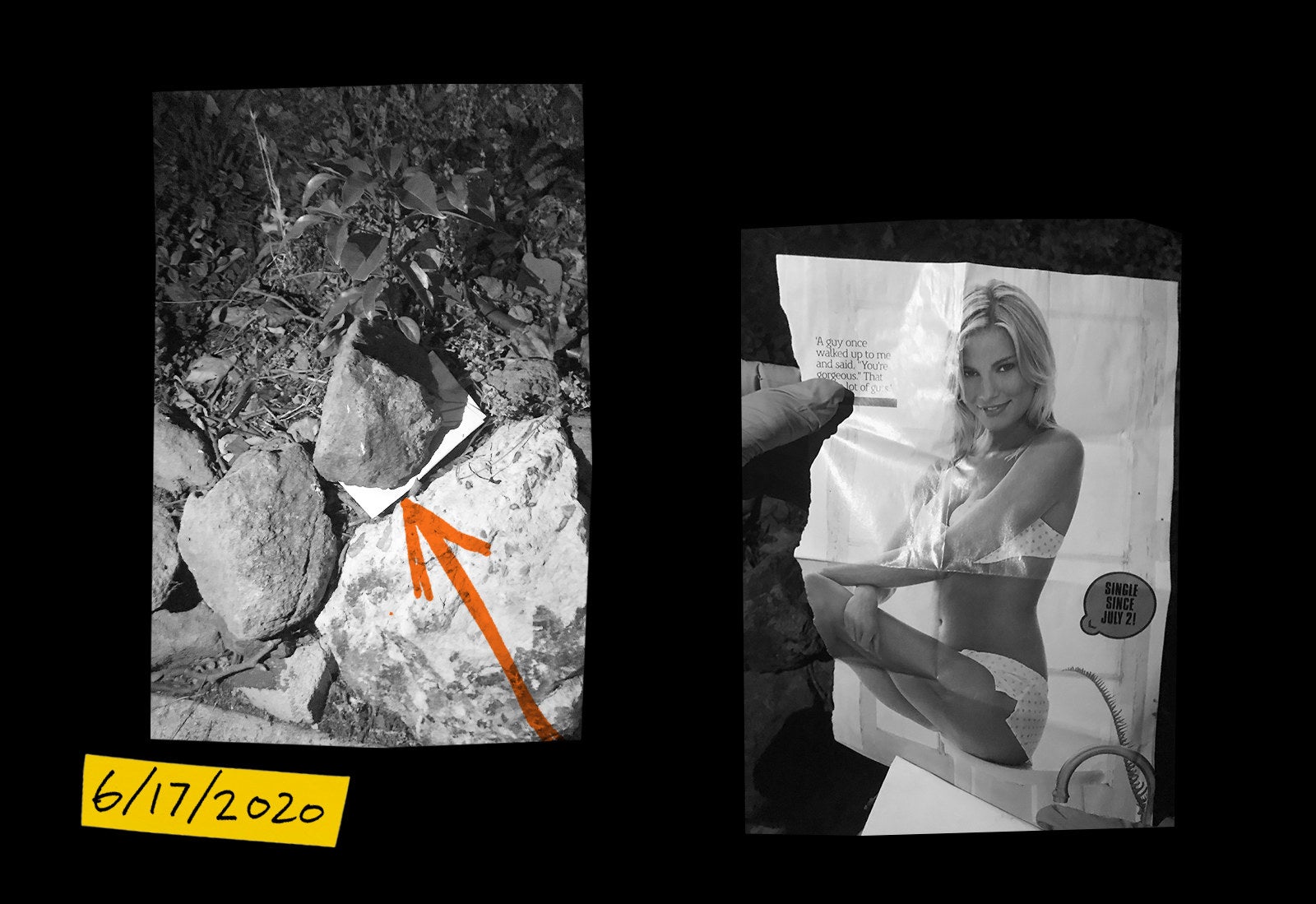
Defining a threat
An LA County Sheriff’s Department officer told us that our work was the most impressive presentation they’d ever seen from a victim. We sent over extensive documentation, including a comprehensive timeline and 59 surveillance videos, with the footage lightly edited and time-stamped for optimal viewing. They even bagged some of the letters and porn mag cutouts to test for DNA.
We were proud of our mountain of evidence. But even more so, we felt lucky. While many people were stressed about paying their rent or trying to juggle parenting and working remotely, we were safely quarantined, with the means and time to focus on building our case, a luxury other potential crime victims might not have.
The department assigned our case to a detective. In the meantime, we went to the courthouse to apply for a temporary restraining order, the first step toward getting a permanent one. After a few bureaucratic speed bumps, we got it.
The next day, my aunt and uncle waited across the street from the neighbor’s house until he got home. Then they jumped out of the car and served him. It didn’t bother me that his wife was there; we felt that she needed to know what he’d been up to on his nightly walks. Unfortunately, his now-adult kids were there too, which wasn’t ideal. But we needed to prioritize ourselves — our safety — over whatever family drama this man’s bad decisions and depraved actions might have incurred.
In early August, about a week before the hearing for the permanent restraining order, we received devastating news from the detective: The district attorney’s office had declined to press felony stalking charges — or any other charges — against the neighbor.
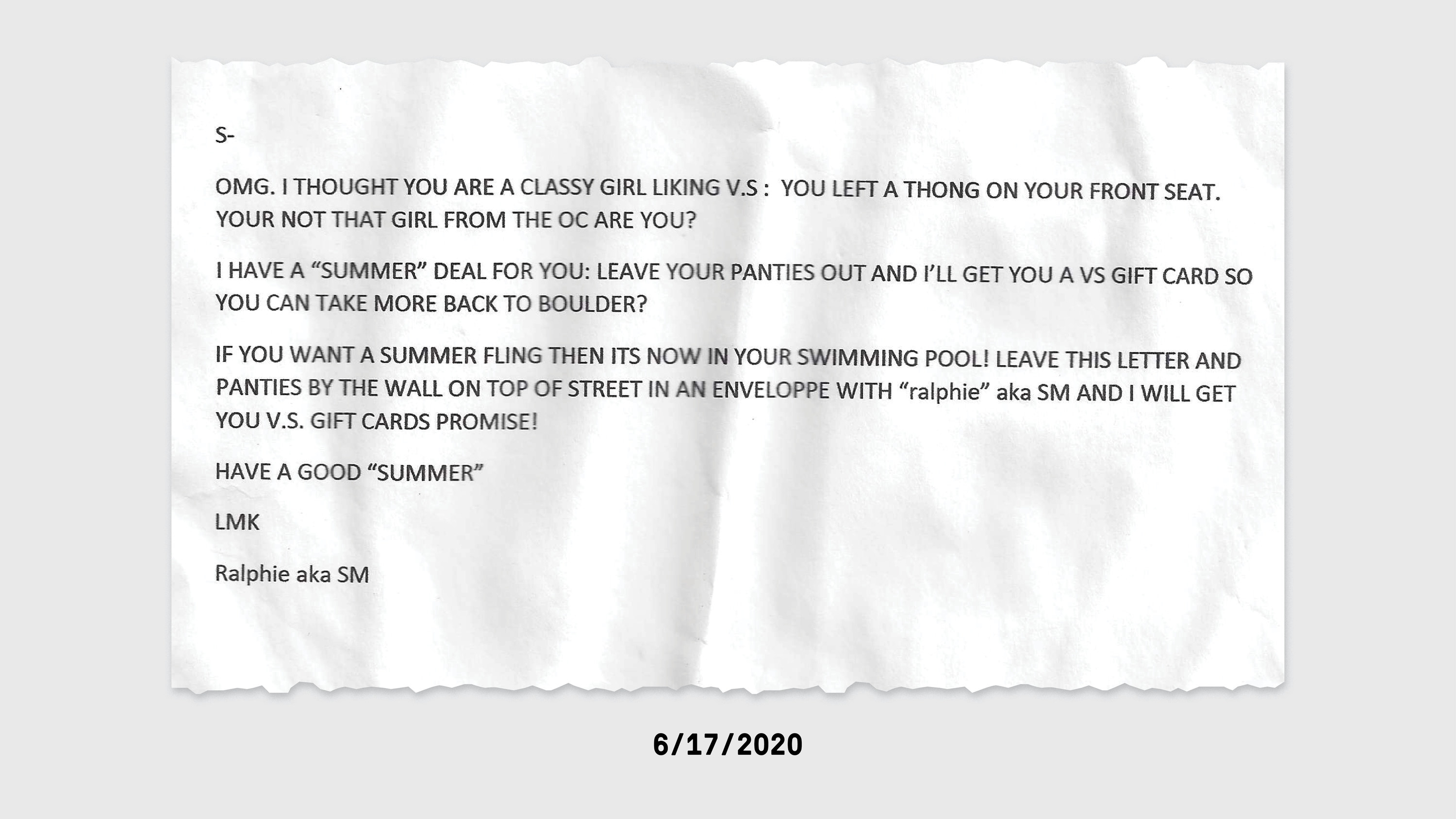
I called the Los Angeles County District Attorney’s Office to get some answers. The prosecutor overseeing the case explained that although she was sympathetic to us, we had insufficient evidence to prove that the neighbor’s actions satisfied all the requirements necessary to warrant a stalking charge — and there are many very specific requirements. For one, even though the neighbor showed up at our house multiple nights a week for months during the pandemic, he hadn’t followed us outside of our home, as far as we knew. He hadn’t made any explicit violent threats toward us, and while there is case law for misdemeanor stalking charges without an overt threat, we’d passed the yearlong statute of limitations for all the events that had occurred in 2015. And despite the glaring similarities between everything that happened in 2015 and 2020 — the notes signed “SM,” the messing with our cars, the missing mail — we didn’t have any actual video evidence of the neighbor doing these things back then, before our cameras were up and running. The prosecutor said she’d considered other smaller charges, like trespassing, but the neighbor had never climbed over a fence or gate, and we didn’t have a sign that clearly stated “no trespassing” in our front yard.
Getting this far had taken a small army and hundreds of hours of our time. The idea that a stalking case could get shut down now was infuriating. It raised troubling questions: Someone savvy enough to refrain from making an overtly violent threat or hopping over a fence can evade accountability? If he satisfies a few — but not all — stalking requirements, he gets off free? And if the victim doesn’t have the time or money or family support to build a case like we did, how can they expect to get so much as a temporary restraining order, let alone actual justice?
The detective told us the case would stay open for the time being, but we realized that getting a judge to grant the long-term restraining order was now more important than ever. It was our last hope.
On the day of the hearing, the neighbor didn’t show up; only his lawyer was present. By this point, my dad had hired a lawyer too. In the hallway outside the courtroom, the attorneys, with our approval, struck a prehearing deal. The civil harassment restraining order would last for two years (as opposed to five), and the neighbor would not contest the accusations or evidence — that is, the copies of the notes, pictures of him tampering with our property, and the police report — that we included in our petition for the restraining order. We insisted that he attend weekly therapy sessions as well. Negotiating with this man seemed absurd, but at least we could move forward with some semblance of peace and security. His actions were now a matter of public record.
Aftermath
In fall 2020, my family was contacted by a local reporter who’d gotten a tip about our story. We were ready for this chapter of our lives to end — but if the story was going to get out, we wanted to ensure they got the facts straight. I agreed to an interview, and my parents gave written statements.
The community was virtually unaware that a potential predator walked among them since he had never been arrested. The neighbor could continue to hold his firm’s annual women’s event. He was free to work with youth organizations. In our eyes, our story would act as a public service announcement for others who might encounter him. Plus, with any luck, it would embolden other young women to speak out as well. Maybe, we thought, the district attorney assigned to the case would have a change of mind about criminal charges in light of new evidence or other people speaking up.
The local newspaper wrote about our experience in a detailed two-part story. The neighbor declined to comment. His family must’ve been humiliated, and we felt for them. They were, after all, victims of his bad choices as well.
When the story came out, social media lit up. Some sleuths at the newspaper tweeted that they might have solved the mystery of the neighbor’s “SM” moniker; they’d found a social media account of his that we’d somehow missed. There he was, clear as day, grinning widely in his profile picture. And his handle? It included the phrase “sexy mexy.”
The neighbor relinquished his various board seats, according to the organizations he had been affiliated with. His firm’s website was taken down and remains that way. This past spring, the neighbor’s house was listed for sale. It sold in May, and a new family has since moved in.
Not long after the article came out, Summer got an Instagram message from a young woman who said she used to live near the neighbor. Back in 2015, she said, her sister had been sent many notes similar to the ones we had received, along with other items, like a jewelry box with a “popped condom” in it. Reading about those similarities in the local newspaper story, she couldn’t help but wonder...
But the story that stuck with me was more than a whisper. It happened after the police had questioned the neighbor and after the hearing — meaning that it happened while he had a restraining order against him. I saw it play out on Nextdoor, a social network for neighbors. A young woman in our neighborhood posted about a bobcat sighting, which is fairly common in and around our area. Looking at her profile picture, she appeared to be Summer’s age and had similar features: blonde, petite, pretty. And there in the comments was the neighbor, so seemingly concerned about this bobcat’s whereabouts — so undeterred by the police investigation into his behavior or the active restraining order against him — that he apparently just couldn’t help but ask the young woman a burning question: “What street do you live on?” ●
